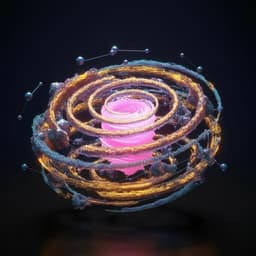
Physics
Heterobilayers of 2D materials as a platform for excitonic superfluidity
S. Gupta, A. Kutana, et al.
This groundbreaking research by Sunny Gupta, Alex Kutana, and Boris I. Yakobson unveils intrinsically stable 2D semiconductor heterostructures poised to revolutionize excitonic condensation. By identifying optimal materials, this study promises to advance superfluid transport, Josephson-like tunneling, and dissipationless charge counterflow.
~3 min • Beginner • English
Introduction
The study addresses the long-standing quest to realize an excitonic condensate—macroscopic quantum phases of bound electron–hole pairs that can exhibit superfluidity and related phenomena. Traditional platforms (bulk semimetals, quantum wells) face challenges such as short exciton lifetimes, weak interlayer Coulomb attraction due to large separations, and disorder. In single-layer 2D materials, proposed excitonic ground states often compete with or are masked by phonon-driven Peierls/charge-density-wave instabilities, making true excitonic condensation difficult to access. The authors posit that realizing both momentum-space and real-space separation between electrons and holes is essential. They propose lattice-matched van der Waals heterobilayers of 2D semiconductors with type-III (broken-gap) or type-II (staggered) band alignment as optimal, equilibrium platforms. In such systems, intrinsic charge transfer arising from work-function differences yields a semimetallic overlap without applied gating, placing electrons and holes in different layers and valleys to suppress detrimental electron–phonon coupling and interband tunneling, thereby favoring excitonic instability and condensation.
Literature Review
Early theories predicted excitonic insulators in bulk semimetals (Mott; Jérome-Rice-Kohn), with phases spanning BEC and BCS limits depending on density and screening. Quantum-well bilayers were proposed to stabilize indirect excitons via spatial separation, but large layer spacing weakens interaction and disorder degrades coherence. With 2D materials, bilayer graphene and other van der Waals heterostructures have been explored theoretically and experimentally; however, most demonstrations require electrostatic doping and operate out of equilibrium, limiting observation of zero-bias Josephson-like effects and incurring dissipation. Monolayer 1T-TiSe2 was suggested as a candidate for an equilibrium excitonic condensate, but strong electron–phonon coupling and a charge-density-wave/Peierls-like instability likely preempt the excitonic ground state. These issues motivate heterobilayers that combine reduced screening, atomically sharp interfaces, and intrinsic carrier overlap while suppressing phonon-driven instabilities.
Methodology
The work combines model Hamiltonian analysis and first-principles calculations to identify and assess 2D heterobilayer platforms for excitonic condensation.
- Model exciton binding and phase diagram: Using an effective-mass Hamiltonian for an electron–hole pair in parabolic bands with spatially separated layers (interlayer distance d ≈ 3 Å), the interlayer Coulomb interaction is modeled by an RPA-screened bilayer potential suitable for metallic bilayers. The screened potential Va(q) = −(2π α/κ)[e^(−q d)/((q + s)^2 − s^2 e^(−2 q d))] includes temperature- and density-dependent screening s; κ = 1 and T = 300 K are assumed for binding estimates. Va(r) is obtained by Fourier transform. Binding energies and wavefunctions are computed by diagonalizing the effective-mass Hamiltonian in a 2D Gaussian basis (size 6), optimized via downhill simplex. Exciton radii and binding energies are mapped versus reduced mass μ and carrier density n to delineate regions of bound interlayer excitons. A semi-quantitative exciton phase diagram is constructed: at low n and larger μ, interlayer excitons condense into a BKT-like superfluid with TBKT from kB TBKT = π ħ^2 n / (2 M); at higher n the condensation crosses over to a BCS-like regime with Tc estimated from self-consistent mean-field solutions of the excitonic gap equations, using the same screened interaction. The BCS order parameter Δ(k) and quasiparticle spectrum E_k = sqrt(ξ_k^2 + Δ_k^2) are obtained self-consistently assuming isotropy. The approach neglects spin-triplet order. Mean-field limitations are noted; QMC would improve accuracy.
- Materials screening and band alignment: From the Materials Cloud database of exfoliable compounds, 258 small-cell monolayers (≤6 atoms/unit cell) are considered; 135 with hexagonal lattices are paired to test lattice matching (Δε < 2% criterion to ensure commensurability needed for zero-momentum pairing). Band edges (relative to vacuum) are recalculated to identify candidate type-III or type-II alignments with small positive or negative gaps. Twenty-three heterobilayers with |ΔE| up to ~0.22 eV and monolayer gaps >0.3 eV are selected for detailed band-structure evaluation.
- First-principles DFT and phonons: Electronic structures, phonon dispersions, and electron–phonon coupling are computed using Quantum ESPRESSO with LDA, fully relativistic ultrasoft pseudopotentials (pslibrary), plane-wave cutoff 60 Ry (higher for select elements), SOC included, dense k-mesh (81×81×1), and structural relaxation to forces < 2.6 meV/Å with 20 Å vacuum. Van der Waals interactions are benchmarked by comparing LDA interlayer distances with PBE-D2 results. Electric-field response is computed with VASP (PAW, 600 eV cutoff). Effective masses are extracted from LDA band structures. For representative systems (e.g., Hf2N2I2/Zr2N2Cl2), phonon spectra and electron–phonon couplings are analyzed to assess Peierls/CDW instabilities, and contrasted with monolayer 1T-TiSe2.
- Carrier density and overlap estimates: A parallel-plate capacitor charge-transfer model connects initial band overlap W0 of isolated layers to carrier density n via classical and quantum capacitances; in stacked heterostructures, final overlap W and n are related by n = W(Ccl + Cq)/e^2(1 + Cq/Ccl). These estimates, combined with DFT-derived masses and interlayer distances, map each candidate onto the exciton phase diagram and yield Tc estimates. External tuning by strain, electric field (~1 V/nm changes n by ~10^12 cm−2), or interlayer spacing is considered to access different regions of the phase diagram.
Key Findings
- Optimal parameter window: Model calculations show interlayer exciton binding is negligible for n ≳ 10^12 cm−2 or for reduced masses μ ≲ 0.03 me. Favorable conditions occur for μ ~ 0.1–0.5 me and n ~ 10^10–5×10^12 cm−2, with TBKT and BCS Tc in the few–tens of kelvin range depending on μ and n. The exciton binding energies exceed kB TBKT in the relevant regime, supporting strongly coupled BKT behavior at low n and a crossover to BCS at higher n.
- Materials identification: Screening of lattice-matched 2D semiconductors with type-III or small type-II alignments yields 23 heterobilayers with final overlaps W in the range ~1–120 meV. Three prime candidates emerge with type-III broken gaps and favorable overlaps: Sb2Te2Se/BiTeCl (W ≈ 67 meV), Hf2N2I2/Zr2N2Cl2 (W ≈ 47 meV), and LiAlTe2/BiTeI (W ≈ 38 meV). Additional promising pair Hf2N2I2/SnS2 is mentioned.
- Equilibrium semimetallicity without gating: Owing to work-function differences, electrons transfer from donor to acceptor layers, producing intrinsic electron–hole populations in separate layers and valleys without applied voltages, thus avoiding leakage and enabling a true-equilibrium excitonic ground state.
- Suppressed Peierls instability: In Hf2N2I2/Zr2N2Cl2, electrons and holes reside on different layers with minimal interlayer hybridization, leading to weak electron–phonon coupling and a dynamically stable phonon spectrum (no unstable modes), in contrast to monolayer 1T-TiSe2 where strong coupling at Q = ΓM drives a CDW/Peierls-like gap. Therefore, excitonic condensation in the heterobilayers is mediated primarily by electronic interactions.
- Estimated critical temperatures and densities: Using DFT-derived effective masses and charge-transfer estimates, carrier densities n > 10^12 cm−2 are obtained for the highlighted heterobilayers, with Hf2N2I2/Zr2N2Cl2 showing an estimated Tc ≈ 31 K from mean-field analysis. Fields/strain can tune n (e.g., ~1 V/nm changes n by ~10^12 cm−2) and thus Tc.
- Practical considerations: For systems with zero modulation vector (e.g., Sb2Te2Se/BiTeCl, LiAlTe2/BiTeI), single-particle hybridization can enable interband tunneling that may pin the condensate phase and suppress superfluidity; inserting an hBN spacer can mitigate tunneling while preserving Coulomb coupling. The mapped phase diagram indicates accessible BEC–BCS crossover by tuning overlap/density.
Discussion
The results demonstrate that carefully selected, lattice-matched 2D semiconductor heterobilayers with broken-gap alignment provide an intrinsic, equilibrium route to excitonic condensation. Real- and k-space separation of electrons and holes minimizes interband tunneling and weakens interlayer electron–phonon coupling, removing Peierls/CDW instabilities that challenge monolayers like 1T-TiSe2. Intrinsic charge transfer sets carrier densities in the optimal window for strong interlayer attraction and condensation, eliminating the need for external doping that introduces dissipation and precludes zero-bias phenomena. The constructed phase diagram contextualizes how specific materials occupy BKT vs BCS regimes and how external fields or strain can move them across the BEC–BCS crossover. Comparative phonon analyses confirm structural stability and electronic decoupling in the best candidates, supporting the feasibility of a superfluid excitonic ground state. Practical device strategies (e.g., hBN spacers) can suppress residual tunneling in zero-Q systems to preserve superfluid phases.
Conclusion
The study identifies specific 2D van der Waals heterobilayers—Sb2Te2Se/BiTeCl, Hf2N2I2/Zr2N2Cl2, LiAlTe2/BiTeI, and Hf2N2I2/SnS2—as promising, intrinsically stable platforms for realizing an equilibrium excitonic condensate without optical pumping or applied gate voltages. A combined model–DFT approach maps the exciton phase diagram and predicts condensate critical temperatures up to tens of kelvin at carrier densities ~10^11–10^13 cm−2. Spatial and valley separation of electrons and holes weakens electron–phonon coupling and avoids Peierls instabilities that complicate monolayer semimetals like TiSe2. The ability to tune band overlap and carrier density with electric fields, strain, or interlayer spacing allows exploration of the BEC–BCS crossover and optimization of Tc. These platforms offer pathways to superfluid transport, Josephson-like interlayer tunneling, and dissipationless counterflow, with further prospects in exciton-spin qubits, excitonic ferromagnetism, spintronics, and novel device geometries (e.g., nested cylindrical heterobilayers with flexoelectric effects). Future work includes experimental synthesis, interface engineering (e.g., dielectric spacers), precision tuning of overlap/density, and beyond-mean-field many-body simulations to refine Tc and phase boundaries.
Limitations
- Mean-field approximations: Tc and gap estimates rely on BCS-like mean-field theory; more accurate many-body methods (e.g., QMC) are needed for quantitative predictions.
- Functional dependence: Carrier densities and overlaps depend on the DFT functional; method-dependent variations impact estimated Tc, though qualitative conclusions persist.
- Interband tunneling: In zero-Q systems (e.g., Sb2Te2Se/BiTeCl, LiAlTe2/BiTeI), band hybridization can enable tunneling that may fix the condensate phase and suppress superfluidity unless mitigated (e.g., with hBN spacers).
- High-density phases: At elevated densities, an electron–hole liquid may be favored over excitonic condensation, potentially limiting accessible regimes.
- Spin effects neglected: Spin-triplet excitonic order is not considered; spin physics may modify phase behavior.
- Experimental constraints: Requirements of lattice matching (Δε < 2%) and precise stacking/clean interfaces may challenge fabrication; external tuning (field/strain) must avoid degrading interlayer binding.
Related Publications
Explore these studies to deepen your understanding of the subject.







